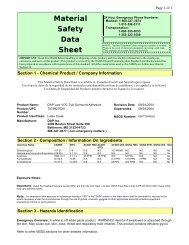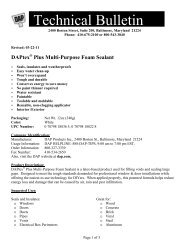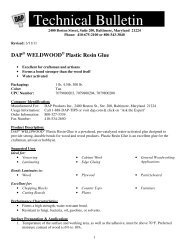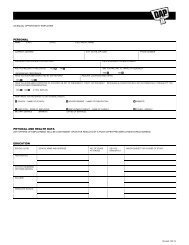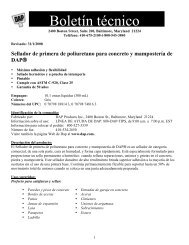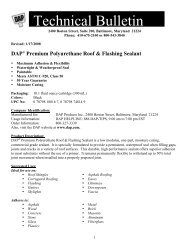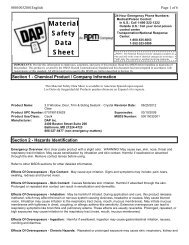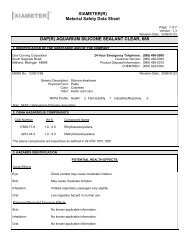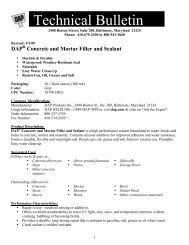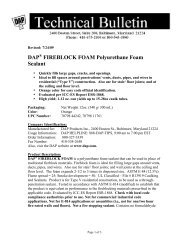00030202 - Dap
00030202 - Dap
00030202 - Dap
You also want an ePaper? Increase the reach of your titles
YUMPU automatically turns print PDFs into web optimized ePapers that Google loves.
<strong>00030202</strong>001English<br />
Page 1 of 7<br />
Material<br />
Safety<br />
Data<br />
Sheet<br />
24 Hour Emergency Phone Numbers:<br />
Medical/Poison Control:<br />
In U.S.: Call 1-800-222-1222<br />
Outside U.S.: Call your local poison<br />
control center<br />
Transportation/National Response<br />
Center:<br />
1-800-535-5053<br />
1-352-323-3500<br />
NOTE: The National Response Center emergency numbers to be used<br />
only in the event of chemical emergencies involving a spill, leak, fire,<br />
exposure or accident involving chemicals.<br />
IMPORTANT: Provide this information to employees, customers, and users of this product. Read this MSDS before handling or disposing of this<br />
product. This product is covered by the OSHA Hazard Communication Standard and this document has been prepared in accordance with requirements of<br />
this standard. All abbreviated terms used in this MSDS are further described in Section 16.<br />
Section 1 - Chemical Product / Company Information<br />
This Material Safety Data Sheet is available in American Spanish upon request.<br />
Los Datos de Serguridad del Producto pueden obtenerse en Espanol si lo riquiere.<br />
Product Name: Weldwood Original Contact Cement Bottle Revision Date: 07/18/2013<br />
Product UPC Number: 070798001022, 070798001053 Supersedes: 08/13/2001<br />
Product Use/Class: Contact Cement MSDS Number: <strong>00030202</strong>001<br />
Manufacturer: DAP Products Inc.<br />
2400 Boston Street Suite 200<br />
Baltimore, MD 21224-4723<br />
888-327-8477 (non-emergency matters)<br />
Section 2 - Hazards Identification<br />
Emergency Overview: A(n) tan liquid product with a strong solvent odor. DANGER! Extremely flammable liquid and vapor.<br />
Vapors may cause flash fire or explosion. Vapors can form an ignitable mixture with air. Vapors can flow along surfaces to a<br />
distant ignition source and flash back. Do not smoke. Extinguish all flames and pilot lights, and turn off stoves, heaters, electric<br />
motors and other sources of ignition during use and until all vapors are gone. Store away from caustics and oxidizers. Keep<br />
container closed and away from heat, sparks, and open flame. Vapors may be harmful if inhaled. Harmful or fatal if swallowed.<br />
Aspiration hazard if swallowed - can enter lungs and cause damage. Aspiration may cause pulmonary edema and pneumonitis.<br />
Irritating to eyes, respiratory system and skin. May affect the brain or nervous system causing dizziness, headache or nausea.<br />
Avoid breathing vapors. Prolonged or repeated inhalation of solvent vapors may cause irregular heartbeat. Use only with<br />
adequate ventilation. Prevent build-up of vapors by opening all windows and doors to achieve cross-ventilation. In case of<br />
insufficient ventilation, wear suitable respiratory equipment.<br />
Refer to other MSDS sections for other detailed information.<br />
Effects Of Overexposure - Eye Contact: May cause eye irritation. Signs and symptoms may include: pain, tears, swelling,<br />
redness and blurred vision.<br />
Effects Of Overexposure - Skin Contact: May cause skin irritation. Prolonged and repeated skin contact may cause dermatitis,<br />
drying and defatting due to the solvent properties.<br />
Effects Of Overexposure - Inhalation: Vapors may be harmful if inhaled. Inhalation of vapors may cause irritation of the nose,<br />
throat, lungs and respiratory tract. Inhalation of vapors in high concentration may cause shortness of breath. Prolonged, repeated<br />
or high exposures may cause central nervous system depression leading to headaches, nausea, drowsiness, dizziness, and<br />
possibly narcosis. In extreme cases, may cause loss of consciousness. Intentional misuse by deliberately concentrating and<br />
inhaling the contents may be harmful or fatal.
<strong>00030202</strong>001English<br />
Page 2 of 7<br />
Effects Of Overexposure - Ingestion: Harmful or fatal if swallowed. May cause gastrointestinal disturbances with dizziness and<br />
central nervous system depression. Ingestion may cause gastrointestinal irritation, nausea, vomiting and diarrhea. If ingested,<br />
may cause depressed respiration. Aspiration hazard if swallowed. Aspiration of material into the lungs due to vomiting can cause<br />
chemical pneumonitis, which can be fatal.<br />
Effects Of Overexposure - Chronic Hazards: Repeated or prolonged exposure may cause skin, respiratory, kidney and liver<br />
damage. NOTICE: Reports have associated repeated and prolonged occupational overexposure to solvents with permanent brain<br />
and nervous system damage. Symptoms include: loss of memory, loss of intellectual ability and loss of coordination. Intentional<br />
misuse by deliberately concentrating and inhaling the contents may be harmful or fatal. Overexposure or misuse of toluene can<br />
cause liver, kidney, and brain damage as well as cardiac abnormalities.<br />
Primary Route(s) Of Entry: Skin Contact, Skin Absorption, Inhalation, Eye Contact<br />
Medical Conditions which May be Aggravated by Exposure: Pre-existing eye, skin and pulmonary disorders may be<br />
aggravated by exposure to this product.<br />
Carcinogenicity:<br />
None<br />
Section 3 - Composition / Information On Ingredients<br />
Chemical Name CASRN Wt%<br />
Toluene 108-88-3 15-40<br />
Acetone 67-64 -1 15-40<br />
Light aliphatic solvent naphtha<br />
n-Heptane<br />
64742-89 -8<br />
142-82-5<br />
7-13<br />
5-10<br />
Methylcyclohexane 108-87-2 0.5-1.5<br />
Section 4 - First Aid Measures<br />
First Aid - Eye Contact: In case of contact, immediately flush eyes with plenty of water for at least 15 minutes. Get medical<br />
attention immediately.<br />
First Aid - Skin Contact: Wash skin with soap and water for 15 minutes. Get medical aid if symptoms persist. Remove and wash<br />
contaminated clothing. To remove from skin, remove completely with a dry cloth or paper towel, before washing with detergent<br />
and water. DO NOT try to peel the solidified material from the skin or use solvents or thinners to dissolve it. The use of vegetable<br />
oil or mineral oil is recommended for removal of this material from the skin. Flush exposed area with water while removing<br />
contaminated clothing. Get medical attention if irritation persists.<br />
First Aid - Inhalation: If inhaled, remove to fresh air. If not breathing, give artificial respiration. If breathing is difficult, give<br />
oxygen. Get medical attention immediately.<br />
NOTE: Only trained personnel should administer artificial respiration or give oxygen.<br />
First Aid - Ingestion: If swallowed, DO NOT INDUCE VOMITING. Get medical attention immediately.<br />
Note to Physician: Inhalation of high concentrations of this material, as could occur in enclosed spaces or during deliberate<br />
abuse, may be associated with cardiac arrhythmias. Sympathomimetic drugs may initiate cardiac arrhythmias in persons exposed<br />
to this material. This material is an aspiration hazard if swallowed. Potential danger from aspiration must be weighed against<br />
possible oral toxicity when deciding whether to induce vomiting. Preexisting disorders of the following organs (may be aggravated<br />
by exposure to this material: skin, lungs (for example, asthma-like conditions). Individuals with preexisting heart disorders may be<br />
more susceptible to arrhythmias (irregular heartbeat) if exposed to high concentrations of this material.<br />
COMMENTS: If over-exposure occurs, call your poison control center at 1-800-222-1222.<br />
Section 5 - Fire Fighting Measures
<strong>00030202</strong>001English<br />
Page 3 of 7<br />
Extinguishing Media: Carbon Dioxide, Dry Chemical, Foam<br />
Unusual Fire And Explosion Hazards: Flammable liquid. Vapors can form an ignitable mixture with air. Vapors can flow along<br />
surfaces to a distant ignition source and flash back. Vapors may form explosive mixtures with air. Eliminate sources of ignition:<br />
heat, electrical equipment, sparks and flames. Containers may explode if exposed to extreme heat. Empty containers retain<br />
product residue (liquid and/or vapor). Vapor can ignite potentially causing an explosion.<br />
Special Firefighting Procedures: Wear self-contained breathing apparatus pressure-demand (NIOSH approved or equivalent)<br />
and full protective gear. Use water spray to cool exposed surfaces.<br />
Section 6 - Accidental Release Measures<br />
Steps To Be Taken If Material Is Released Or Spilled: Wear proper protective equipment as specified in Section 8. Immediately<br />
eliminate sources of ignition. Dike to prevent entering any sewer or waterway. Transfer liquid to a holding container. Contain<br />
spilled material and remove with inert absorbent. Dispose of contaminated absorbent, container and unused contents in<br />
accordance with local, state and federal regulations. Scrape up dried material and place into containers.<br />
Section 7 - Handling And Storage<br />
Handling: KEEP OUT OF REACH OF CHILDREN! DO NOT TAKE INTERNALLY. Flammable liquid. Avoid heat, sparks and open<br />
flames. Keep away from open flames, hot surfaces and sources of ignition. Use in well ventilated area. Open all windows and<br />
doors or use other means to ensure cross-ventilation and fresh air entry during application and drying. Avoid breathing vapor and<br />
contact with eyes, skin and clothing. Intentional misuse by deliberately concentrating and inhaling vapors may be harmful or fatal.<br />
Construction and repair activities can adversely affect indoor air quality. Consult with occupants or a representative (i.e.<br />
maintenance, building manager, industrial hygienist, or safety officer) to determine ways to minimize impact.<br />
Storage: Store away from sources of ignition and heat. Keep containers tightly closed. Do not store at temperatures above 120<br />
degrees F. Store containers away from excessive heat and freezing. Store away from caustics and oxidizers.<br />
Section 8 - Exposure Controls / Personal Protection<br />
Chemical Name CASRN ACGIH TWA ACGIH STEL ACGIH CEIL OSHA TWA OSHA STEL OSHA CEIL Skin<br />
Toluene 108-88-3 20 PPM N.E. N.E. 200 PPM N.E. 300 PPM Yes<br />
Acetone 67-64-1 500 PPM 750 PPM N.E. 1000 PPM N.E. N.E. No<br />
Light aliphatic solvent naphtha 64742-89-8 300 PPM N.E. N.E. 300 PPM 400 PPM N.E. No<br />
n-Heptane 142-82-5 400 PPM 500 PPM N.E. 500 PPM N.E. N.E. No<br />
Methylcyclohexane 108-87-2 400 PPM 500 PPM N.E. 500 PPM N.E. N.E. No<br />
Important: Listed Permissible Exposure Levels (PEL) are from the U.S. Dept. of Labor OSHA Final Rule Limits (CFR 29 1910.1000); these limits may vary between<br />
states.<br />
Note: An employee's skin exposure to substances having a "YES" in the "SKIN" column in the table above shall be prevented or reduced to the extent necessary under<br />
the circumstances through the use of gloves, coveralls, goggles or other appropriate personal protective equipment, engineering controls or work practices.<br />
Exposure Notes:<br />
None<br />
Precautionary Measures: Please refer to other sections and subsections of this MSDS.<br />
Engineering Controls: Use only in well-ventilated areas. Vapors are heavier than air and may spread along floors. Check all low<br />
areas for presence of vapor. Provide sufficient general and/or local exhaust ventilation to maintain exposure below recommended<br />
exposure limit. The following exposure control techniques may be used to effectively minimize employee exposure: local exhaust<br />
ventilation, enclosed system design, process isolation and remote control in combination with appropriate use of personal<br />
protective equipment and prudent work practices. These techniques may not necessarily address all issues pertaining to your<br />
operations. We, therefore, recommend that you consult with experts of your choice to determine whether or not your programs are<br />
adequate.
<strong>00030202</strong>001English<br />
Page 4 of 7<br />
If airborne contaminants are generated when the material is heated or handled, sufficient ventilation in volume and air flow<br />
patterns should be provided to keep air contaminant concentration levels below acceptable criteria.<br />
Respiratory Protection: In case of insufficient ventilation, wear suitable respiratory equipment. If concentrations exceed the<br />
exposure limits specified, use of a NIOSH-approved supplied air respirator is recommended. Where the protection factor is<br />
exceeded, use of a Self Contained Breathing Apparatus (SCBA) may be necessary. A respiratory protection program that meets<br />
the OSHA 1910.134 and ANSI Z88.2 requirements must be followed whenever workplace conditions warrant a respirator's use.<br />
Skin Protection: Solvent-resistant gloves.<br />
Eye Protection: Goggles or safety glasses with side shields.<br />
Other protective equipment: Provide eyewash and solvent impervious apron if body contact may occur.<br />
Hygienic Practices: Remove and wash contaminated clothing before re-use.<br />
Section 9 - Physical And Chemical Properties<br />
Boiling Range: Not Established Vapor Density: Heavier Than Air<br />
Odor: Strong Solvent Odor Threshold: Not Established<br />
Color: Tan Evaporation Rate: Faster Than n-Butyl Acetate<br />
Solubility in H2O: Not Established Specific Gravity: 0.85<br />
Freeze Point: Not Established pH: Not Applicable<br />
Vapor Pressure: Not Established Viscosity: Not Established<br />
Physical State: Liquid Flammability: Extremely Flammable<br />
Flash Point, F: -50 F Method: (Seta Closed Cup)<br />
Lower Explosive Limit, %: Not Determined Upper Explosive Limit, %: Not Determined<br />
When reported, vapor pressure of this product has been calculated theoretically based on its constituent makeup and has not been determined experimentally.<br />
(See section 16 for abbreviation legend)<br />
Section 10 - Stability And Reactivity<br />
Conditions To Avoid: Excessive heat and freezing. Avoid contact with skin, eyes and clothing. Keep away from open flames, hot<br />
surfaces and sources of ignition. Keep away from oxidizing agents, strongly alkaline and strongly acid materials in order to avoid<br />
exothermic reactions.<br />
Incompatibility: Incompatible with strong bases and oxidizing agents. Avoid contact with strong acids and oxidizable organic<br />
materials in the presence of heat. Incompatible with open flames, hot surfaces and sources of ignition.<br />
Hazardous Decomposition Products: Normal decomposition products, i.e., COx, NOx.<br />
Hazardous Polymerization: Hazardous polymerization will not occur under normal conditions.<br />
Stability: Stable under recommended storage conditions.<br />
Section 11 - Toxicological Information<br />
Product LD50: Not Established<br />
Product LC50: Not Established<br />
CASRN Chemical Name LD50 LC50<br />
108-88-3 Toluene ------------- Rat:49 gm/m3/4H<br />
67-64-1 Acetone ------------- Rat:50100 mg/m3/8H<br />
142-82-5 n-Heptane ------------- Rat:103 gm/m3/4H<br />
108-87-2 Methylcyclohexane Mice:2250 mg/kg MIC:41500 mg/m3/2H<br />
Significant Data with Possible Relevance to Humans: None.
<strong>00030202</strong>001English<br />
Page 5 of 7<br />
Section 12 - Ecological Information<br />
Ecological Information: Ecological injuries are not known or expected under normal use.<br />
Section 13 - Disposal Information<br />
Disposal Information: Dispose of material in accordance with all federal, state and local regulations. State and Local<br />
regulations/restrictions are complex and may differ from Federal regulations. Responsibility for proper waste disposal is with the<br />
owner of the waste. Liquids cannot be disposed of in a landfill. Discarded material should be incinerated at a permitted facility. Do<br />
not re-use empty containers.<br />
EPA Waste Code if Discarded (40 CFR Section 261): D001.<br />
Section 14 - Transportation Information<br />
DOT Proper Shipping Name: Adhesives, containing a flammable Packing Group: III<br />
liquid<br />
DOT Technical Name: N.A. Hazard Subclass: N.A.<br />
DOT Hazard Class: 3 Flammable liquid DOT UN/NA Number: UN1133<br />
Section 15 - Regulatory Information<br />
CERCLA - SARA Hazard Category:<br />
This product has been reviewed according to the EPA 'Hazard Categories' promulgated under Sections 311 and 312 of the<br />
Superfund Amendment and Reauthorization Act of 1986 (SARA Title III) and is considered, under applicable definitions, to meet<br />
the following categories:<br />
Immediate Health Hazard, Chronic Health Hazard, Fire Hazard<br />
SARA Section 313:<br />
This product contains the following substances subject to the reporting requirements of Section 313 of Title III of the Superfund<br />
Amendment and Reauthorization Act of 1986 and 40 CFR part 372:<br />
Chemical Name<br />
Toluene 108-88-3<br />
CAS Number<br />
Toxic Substances Control Act:<br />
All ingredients in this product are either on TSCA inventory list, or otherwise exempt.<br />
This product contains the following chemical substances subject to the reporting requirements of TSCA 12(B) if exported from the<br />
United States:<br />
Chemical Name<br />
n-Heptane 142-82-5<br />
CAS Number<br />
New Jersey Right-to-Know:
<strong>00030202</strong>001English<br />
Page 6 of 7<br />
The following materials are non-hazardous, but are among the top five components in this product:<br />
Polychlorinated Rubber<br />
Phenolic resin<br />
Chemical Name<br />
Proprietary<br />
Proprietary<br />
CAS Number<br />
Pennsylvania Right-to-Know:<br />
The following non-hazardous ingredients are present in the product at greater than 3%:<br />
Polychlorinated Rubber<br />
Phenolic resin<br />
Chemical Name<br />
Proprietary<br />
Proprietary<br />
CAS Number<br />
California Proposition 65:<br />
WARNING: This product contains chemicals known to the State of California to cause cancer, birth defects or other reproductive<br />
harm.<br />
Section 16 - Other Information<br />
HMIS Ratings:<br />
Health: 2 Flammability: 3 Reactivity: 0 Personal Protection: X<br />
Volatile Organic Compounds (VOC), less water less exempts: g/L: 646.5 lb/gal: 5.40 wt:wt%: 53.8<br />
Volatile Organic Compounds (VOC), less water less exempts, less LVP-VOCs: wt:wt%: 65.7<br />
REASON FOR REVISION: Periodic Update<br />
Legend: N.A. – Not Applicable ACGIH – American Conference of Governmental Industrial Hygienists<br />
N.E. – Not Established SARA – Superfund Amendments and Reauthorization Act of 1986<br />
N.D. – Not Determined<br />
NJRTK – New Jersey Right-to-Know Law<br />
VOC – Volatile Organic Compound<br />
OSHA – Occupational Safety and Health Administration<br />
PEL – Permissible Exposure Limit<br />
HMIS – Hazardous Materials Identification System<br />
TLV – Threshold Limit Value<br />
NTP – National Toxicology Program<br />
CEIL – Ceiling Exposure Limit<br />
STEL – Short Term Exposure Limit<br />
LD50 – Lethal Dose 50 LC50 – Lethal Concentration 50<br />
F – Degree Fahrenheit<br />
MSDS – Material Safety Data Sheet<br />
C – Degree Celsius<br />
CASRN – The Chemical Abstracts Service Registry Number<br />
DAP believes the data and statements contained herein are accurate as of the date hereof. They are offered in good faith as typical values and
<strong>00030202</strong>001English<br />
Page 7 of 7<br />
not as a product specification. NO WARRANTY OF MERCHANTABILITY, WARRANTY OF FITNESS FOR ANY PARTICULAR<br />
PURPOSE OR ANY OTHER WARRANTY, EXPRESS OR IMPLIED, IS MADE WITH REGARD TO THE INFORMATION<br />
HEREIN PROVIDED OR THE PRODUCT TO WHICH THE INFORMATION REFERS. Since this document is intended only as a<br />
guide to the appropriate use and precautionary handling of the referenced product by a properly trained person, it is therefore the responsibility<br />
of the user to (i) review the recommendations with due consideration for the specific context of the intended use and (ii) determine if they are<br />
appropriate.<br />



